India's Third Giant Leap
This Could be One of the Biggest Opportunities for Investors
- Home
- Views On News
- Jan 16, 2023 - Bajaj Finance: Death at a Funeral
Bajaj Finance: Death at a Funeral

An unwritten rule on Dalal street is that you should never fall in love with a stock. But with some companies, investors just can't help themselves...
Bajaj Finance Ltd (BFL), a Nifty 50 company, has been a market darling for long, rewarding its loyal shareholders with generational wealth.
From a price of just Rs 3.2 on 1 January, 2002 to its 52-week high of Rs 8,043 reached on 19 January, 2022, the stock delivered an unimaginable return of 251,250%
That's Rs 10,000 magically transformed in to Rs 26.8 million (m) in just 20 years! With such a phenomenal performance, who is to blame them...
A strong belief in the company's products, an exceptional management team and the long-term success of its business has created a cult-like aura around the stock, driving its price to sky-high valuations.
But in recent times, a mood of gloom has set in for investors as the stock has been in a free fall over the last few weeks.
Initially, investors looked at it as a correction in price which provided a buying opportunity but there has been no reversal in the stocks trajectory.
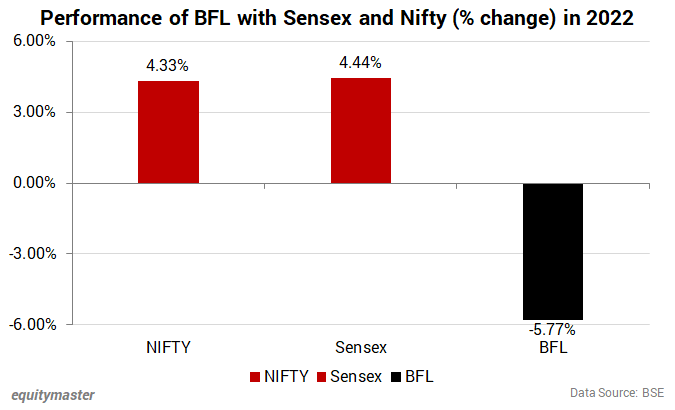
In 2022, BFL underperformed both the Sensex and NIFTY for the first time in 14 years. Worst yet, this was the first negative annual return since 2011.
2023 has been no better... The stock is down another 9% in the first few days of the new year, once again underperforming the Sensex which is down only by 0.9%.
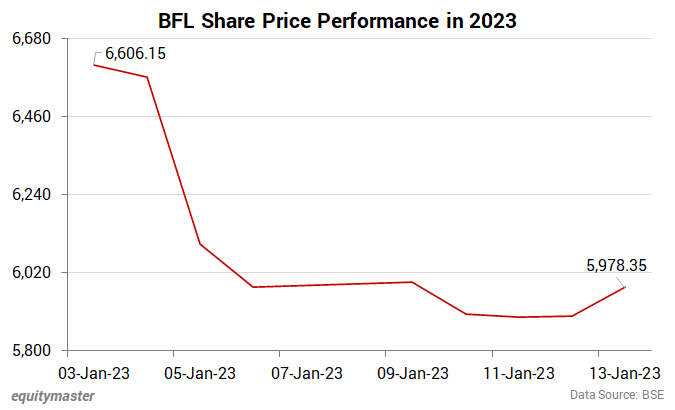
The word on the street is that the stock could be in for a major correction and the worst is yet to come.
For the first time, the company's most loyal shareholders and proponents are beginning to wonder if this is just a temporary setback or the beginning of a gradual decline in the fortunes of the company.
So, which is it?
In this article, we attempt to piece together what exactly is happening with Bajaj Finance and how the ongoing paradigm shift in the NBFC space is set to affect the company and the entire industry it operates within.
Bajaj Finance: The Beginning
Let's start at the beginning...
Before BFL became this massive financial giant, it was earlier known as Bajaj Auto Finance (name changed to Bajaj Finance Ltd in 2010), which essentially lent money to buy motorcycles manufactured by Bajaj.
Primarily, a captive business lending for Bajaj Auto's products, it provided assured business for Bajaj Auto Finance but the company was at best puny compared to what it is today.
In 2006, the company reported income of Rs 2.1 billion (bn) and a profit after tax (PAT) of Rs 376 million (m).
For the financial year ended 31 March 2022, the company's income and net profit has jumped multi-fold to Rs 202.9 bn and Rs 63.5 bn respectively.
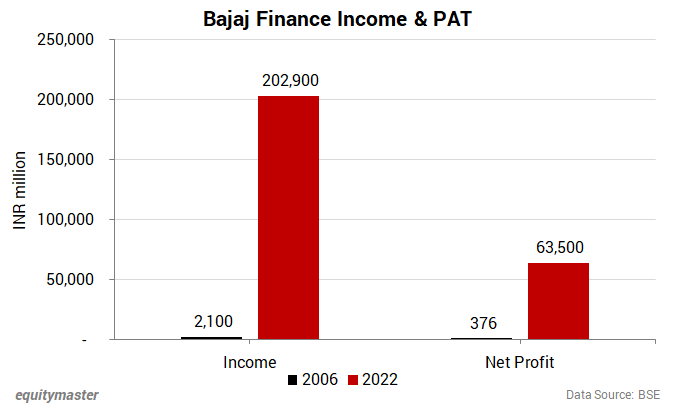
So, what made Bajaj Finance grow the way it did?
Back in 2006, Sanjiv Bajaj, Chairman, Bajaj Finance realised that being a monoline business could be detrimental if private banks also decided to get into that space. With their sheer size and presence, they could easily wipe out a player like Bajaj Auto Finance.
Hence, while transforming the company into Bajaj Finance, he consciously decided for the business to become multiline across automobiles, consumer, SME, rural and commercial businesses.
But it was the company's entry into the consumer durables finance sector by offering small-size loans at zero interest rates that began the incredible Bajaj Finance story.
The company's first mover advantage in the arena of consumer lending and its interest-free Equated Monthly Instalments (EMI) worked wonders for the company.
Between 2006 and 2022, the company's assets under management (AUM) grew at a CAGR of 35%.
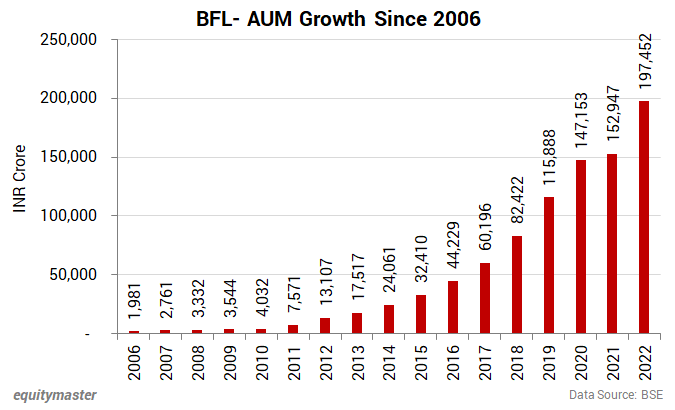
Unbelievable, right?
Oh, but wait... did we mention the growth in income and profits?
Between 2006-2022, income and net profit grew at a CAGR of 36.7% and 38.8% respectively!
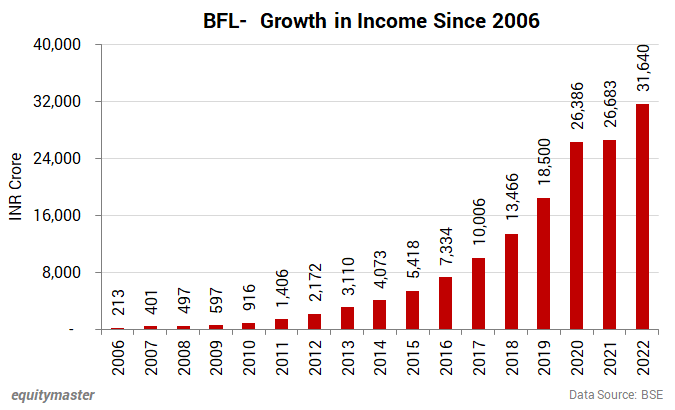
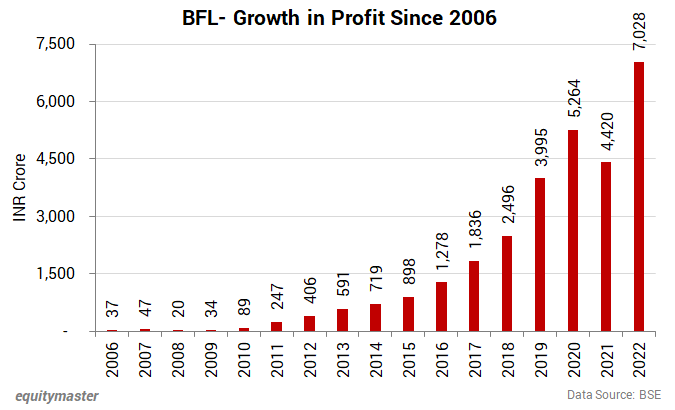
With such unheard-of growth, the company soon became the superstar of the NBFC industry, far ahead of the competition.
Due to this high growth rate, the stock was rerated from two times, the one-year forward book value to nearly eight times, the one-year forward book value over the same period.
This was the primary reason why BFL has always enjoyed an exceptionally high PE ratio as against its peers as investors believed its continued growth justified the high valuations.
Even after the recent correction, the PE ratio of the company is much higher as compared to its peers.
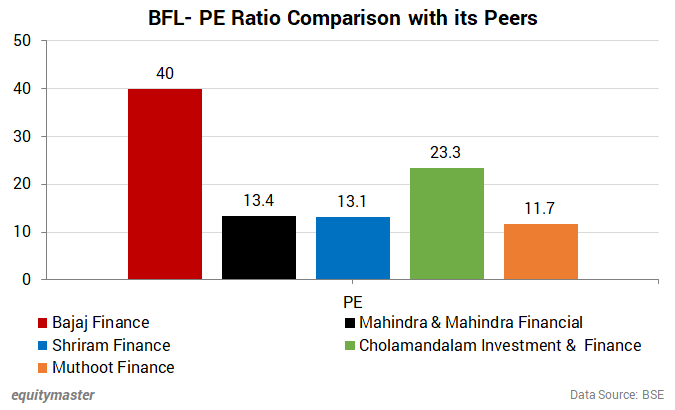
But as the saying goes, "All good things must come to an end"
Or pause...
Or at least slow down!
Bajaj Finance: Losing the Midas Touch?
At the onset, let us be clear. BFL is still the largest NBFC, miles ahead of its peers. And it's not stopped growing either. In fact, for a company of its size, it continues to astound investors with its continuous growth quarter after quarter.
Alas, the markets are fickle, and at times, quite brutal...
In recent times, some experts have pointed out that although the company still continues to grow, the rate of growth has slowed down.
But is that the case? Well, let's break down the company's key performance highlights in two periods of time.
| (CAGR%) | FY2006 to FY2019 | FY2020 to FY2022 |
|---|---|---|
| AUM | 36.70% | 19.40% |
| Income | 41% | 19.60% |
| Net Profit | 43.30% | 20.70% |
Looking at the numbers, we can notice there has been a sharp drop in the growth rate.
But then, one might argue that the company's operations were significantly hampered due to strict lockdowns across most parts of India and the EMI moratorium during the pandemic.
Let's dig deeper by comparing the quarterly data, before the pandemic and after the economy was back to normal post the second wave to see if there is any truth to it.
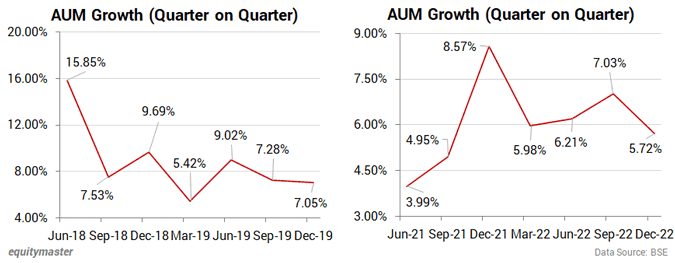
Between June 2018 and December 2019 (the quarter right before the pandemic hit the world), BFL's AUM grew at an average of 8.8% quarter on quarter.
However, if we look at the numbers between June 2021 till the latest quarter ended December 2022, the average growth rate of AUM per quarter is down to 6%
Likewise, income and profits have also been growing, albeit at a slower rate over the last few quarters as compared to earlier.
Hence, we can establish from the numbers, that growth has moderated and BFL's quarter-on-quarter (QoQ) AUM growth is the lowest seen over the last decade.
This has not gone down well with market participants as it has not met their high expectations from the company.
But then again, one can put it down to the size and scale of the company. After all the company's AUM is much larger when compared to the other prominent players.
| (INR Crore) | AUM | AUM | AUM | AUM | AUM |
|---|---|---|---|---|---|
| FY 2022 | Jun-21 | Jun-22 | Sep-21 | Sep-22 | |
| Bajaj Finance | 1,97,452 | 1,59,057 | 2,04,018 | 1,66,937 | 2,18,366 |
| Growth in Quarterly AUM (YOY%) | 28% | 31% | |||
| Cholamandalam Inv & Finance | 76,907 | 67,821 | 81,925 | 70,023 | 87,668 |
| Growth in Quarterly AUM (YOY%) | 21% | 25% | |||
| Poonawalla Fincorp Ltd | 16,579 | 14,475 | 17,660 | 15,213 | 18,560 |
| Growth in Quarterly AUM (YOY%) | 22% | 22% | |||
| Mahindra & Mahindra Financial | 64,961 | 63,562 | 67,693 | 63,635 | 73,817 |
| Growth in Quarterly AUM (YOY%) | 6% | 16% | |||
| Muthoot Finance | 58,053 | 52,613 | 56,689 | 55,146 | 57,230 |
| Growth in Quarterly AUM (YOY%) | 8% | 4% | |||
| Shriram Finance (Combined after Merger)* | 1,65,581 | 1,52,810 | 1,71,104 | 1,56,327 | 1,77,913 |
| Growth in Quarterly AUM (YOY%) | 12% | 14% |
However, what has got the markets riled is that in recent quarters, while BFL's growth rate has moderated from the earlier CAGR of 37% to between 27-30% now, the growth differential that it had against its peer group has also narrowed.
For instance, BFL's AUM growth YOY for the quarters of June, September and December 2022 were at 28%,31% and 27% respectively.
Now, lets look at the YOY AUM growth for Cholamandalam Investment & Finance. Its increased from 21% in the June 2022 quarter to 25% in September 2022 quarter. The company has given guidance that they expect this momentum to sustain at 25% going forward.
Then there is Poonawalla Fincorp which has consistently grown its AUM YOY for the quarters of June and September 2022 at 22% each. For December 2022, the growth has improved to 28% YOY.
Mahindra & Mahindra Financials' AUM which grew at 6% and 16% YOY for the quarters of June 2022 and September 2022 has also reported an improvement in AUM growth for the December 2022 quarter to 21% YOY.
You see where this is going?
On one hand, BFL has reached a massive size. This is basically the law of large numbers. When a company gets too big, each percentage of incremental revenue suddenly represents a fundamentally larger number. Hence, growth rate is naturally expected to moderate as is the case with BFL.
On the other hand, we can see that the peer group, unlike earlier, is now growing almost as fast as BFL.
This is the first time that the company finds itself in such a precarious position ever since it began its accession to the top over 15 years ago.
Hence, it seems a valuation multiple de-rating is happening currently with BFL as its AUM growth tapers down while growth differentials with peers simultaneously continues to narrow as well.
Many Davids and the Goliaths...
Bajaj Finance has always been the company to beat in the NBFC space. With an AUM of Rs 2.3 trillion, it towers over its competitors.
In this David vs Goliath story, the many Davids put together have not been able to get the better of this giant, Goliath- Bajaj Finance.
But over the last couple of years, there have been sweeping changes to the NBFC landscape.
The Davids have increased in numbers... earlier there were a handful of players competing with BFL for market share.
But in recent times, the numbers have increased manifold. Even private banks such as ICICI Bank and HDFC Bank have been focusing on financing consumer durables that has always been the domain of Bajaj Finance.
Market participants now compare Bajaj Finance with HDFC as well as HDFC Bank.
Because of the increased level of competition in the consumer lending market, BFL has found it tougher to get existing clients to take out additional loans. The share of BFL's clients taking out new loans has dropped to 35% from a high of 58% in 2019.
Then there is another "David"- Poonawalla Fincorp, which has suddenly become Dalal street's new darling after billionaire Adar Poonawalla acquired the company, earlier known as Magma Fincorp in May 2021.
Optimistic investors believe that the company might be the Bajaj Finance of the future.
The stock has rallied 388% over the last 3 years on the back of a stronger management force post-acquisition. BFL shares have risen 42% over the same period.
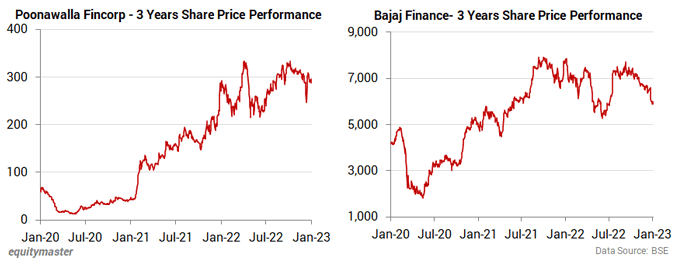
For the December 2022 quarter, Poonawalla Fincorp registered 116% jump in total disbursements to approximately Rs 39.8 bn as against December 2021.
The NBFC aims to grow its assets under management 3 times from the current levels by FY25, and be among the top 3 NBFCs for both consumers and medium and small and medium enterprises.
Other smaller players including Aditya Birla Capital, Tata Capital, L&T Finance continue to chip away at the company's market share.
And if the Davids weren't enough... enter not one but two other Goliaths!
The merger of Shriram Transport Finance Company Limited, Shriram City Union Finance Ltd and amalgamation involving various Shriram group entities, has resulted in the new entity named Shriram Finance Ltd (SFL) becoming a diversified player and the second largest retail NBFC with an AUM of Rs 1.71 trillion as on September 30, 2022 just second to BFL.
Analysts believe AUM should grow at 15% between FY2023 to FY2025, hence maintaining pressure on BFL going forward.
And finally, the big bully has entered the play arena... the second Goliath that has got even the most staunch supporters of BFL anxious is the entry of the biggest disruptor of all, Reliance group.
In October 2022, the board of Reliance Industries approved a scheme to demerge the financial services business from Reliance Industries into a new company to be called Jio Financial Services (JFS)
It seems that JFS will be focused on consumer and merchant lending, which is the mainstay of Bajaj Finance.
A new report by Macquarie Research says that JFS could emerge as the fifth largest financial services company in terms of net worth.
The Macquarie report said,
- "Reliance group has a network of more than 15,000 stores across several formats and a vast customer base (400 million in telecom and 200 million in retail) that JFS can leverage and, in concept, be a formidable threat for incumbents.
Jio Financial will have a significant advantage over other NBFCs due to its deep-pocketed parentage, AAA credit rating, strong and well-capitalised balance sheet, very large distribution footprint and strong ability to attract top-notch talent.
Among NBFCs and fintech, Bajaj Finance and Paytm could be the most at risk, it said."
It seems the Reliance group is expected to not only go big on financial services, but also to become a disruptor in the sector. It is likely to take a page or two out of its Jio strategy which disrupted the Indian telecom industry decimating the competition.
This is one Goliath that Bajaj Finance will have to dig its heels in and fight out. And that's one of the major concerns that have gripped the company's shareholders and led to the ensuing free fall in its stock price.
Bajaj Finance: The Price You Pay for Being too Big
Wait, there is more? You ask...
Sadly, there is one more thing ailing the company as well as the entire NBFC industry.
In recent years, the Reserve Bank of India (RBI) has been tightening the rules for non-banking finance companies (NBFCs).
After the collapse of infrastructure major, Infrastructure Leasing & Financial Services (IL&FS) in 2018 and subsequent failures of leading NBFCs like Reliance Capital and Dewan Housing Finance, the RBI has been tightening screws on systemically important NBFCs, bringing their regulation on par with that of commercial banks.
In September 2022, RBI identified 16 large non-banking finance companies, including Bajaj Finance, under the 'Upper Layer' for bank like compliances.
As per the guidance, these entities have been asked to migrate to a bank-like regulatory system.
The regulatory framework includes higher capital adequacy, leverage requirement, liquidity position, standard asset provisioning and governance structure including board and remuneration policies.
Currently, the top NBFCs such as Bajaj Finance, Mahindra Financial, Tata Capital , Aditya Birla are very well stock with capital and also follow good governance practices.
However, as regulations are more or less similar to banks, it puts these NBFC's at a disadvantage compared to banks which have cheaper access to funds.
Additionally, competition is expected to be more intense from banks which are flush with low-cost deposits and better placed with improved capital buffer than in the previous years.
The goal of the RBI is for large NBFCs such as Bajaj Finance to expand in a controlled manner.
Having ruled out the possibility of applying for a bank licence earlier, BFL may now have to deal with slower growth rates going forward.
BFL: Acceptance is the First Step to Recovery
For a long period of time, BFL has been the favourite financial services stock among investors, providing them with consistently high returns year after year.
While the company even today remains the market leader, growth has moderated and the growth rate may taper even further going forward.
As the company continues its digital transformation, BFL itself would be more focused on quality over quantity as its AUM has reached a very large size for a non-banking entity.
Thus, investors need to factor this in and have more realistic expectations from the company over the coming years.
Existing as well as new investors looking at entering the stock after this correction may find it prudent to understand that the company has reached a certain point in its life cycle where it needs to take a breather and focus on normalisation of asset quality.
BFL is in a way akin to a company like Tata Consultancy Services (TCS).
If we look at TCS, the company has a higher PE ratio as compared to its peers, Infosys, HCL Technologies and Wipro and it continues to maintain this premium because of its unchallenged market leadership.
Similarly, BFL might continue to remain the most expensively priced NBFC stock even yet due to its strong pedigree.
But as the growth differential narrows between its peers, some amount of this premium is bound to shrink and that is exactly what's been happening in recent times.
As they say the first step in the healing process is acceptance...
Investors must accept this as the new normal and not expect the stock to be the multi-bagger that it was in the last decade.
You can also check out the video version of this editorial on Equitymaster's YouTube channel.
Investment in securities market are subject to market risks. Read all the related documents carefully before investing
Out Now
3 High Conviction Stocks
Chosen by Rahul Shah, Tanushree Banerjee and Richa Agarwal
Report Available
Details of our SEBI Research Analyst registration are mentioned on our website - www.equitymaster.comDisclaimer: This article is for information purposes only. It is not a stock recommendation and should not be treated as such. Learn more about our recommendation services here...

Yazad Pavri
Cool Dad, Biker Boy, Terrible Dancer, Financial writer
I am a Batman fan who also does some financial writing in that order. Traded in my first stock in my pre-teen years, got an IIM tag if that matters, spent 15 years running my own NBFC and now here I am... Writing is my passion. Also, other than writing, I'm completely unemployable!
Equitymaster requests your view! Post a comment on "Bajaj Finance: Death at a Funeral". Click here!
3 Responses to "Bajaj Finance: Death at a Funeral"
Uday Shankar Konkankar
Jan 19, 2023Excellent. well dissected article. We need more such articles from Equity Master rather than just find reasons as to why a particular stock has fallen, which is obvious


VINAY AGARWAL
Jan 21, 2023Thanks for this insightful article which touched upon essential investing principles, market insights and road ahead
However, in my opinion, title is too harsh for such a great company and management